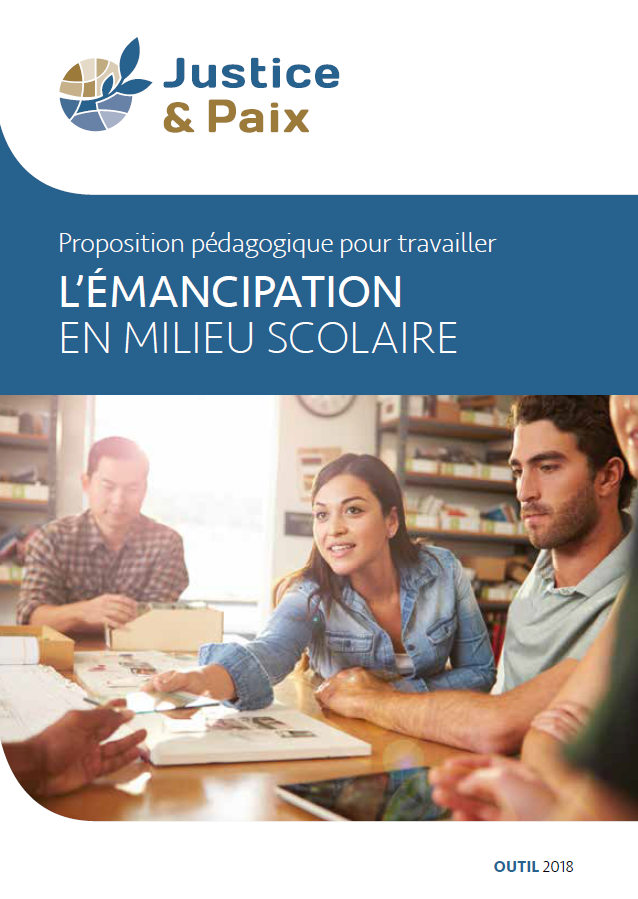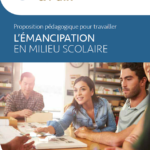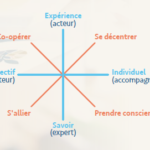Emancipation is one of the central missions of the school. It aims to prepare students to be responsible citizens so that they contribute to a democratic, united, pluralistic society open to other cultures. However, when we look at today's schools, this objective does not seem to be a priority. Even more, teachers often feel helpless to carry out this mission.

At Justice and Peace, we have taken the reflection further. What is emancipation? In order to overcome the shortcomings of our school system, what would a truly emancipatory school be? What can continuing education bring? , whose emancipation is the main goal, to the world of school? Finally, what tool can we offer school stakeholders, mainly teachers, to question their relationship to emancipation? We tried to answer all these questions in the study “A school outside the walls. Transmission, emancipation, citizenship”. We are interested in the limits of our education system. We note the current rapprochement between school and business. “Results-oriented” approach, directly mobilizable skills, promotion of individual performance, meetings between young people and businesses, etc. are signs of a desire to further adapt the “training” (a word that can be questioned in itself because it has a different connotation from that of “education”) of students to the needs of the labor market. The logic of academic failure and repetition also contributes to the perception of an exclusionary school. It finds itself in perpetual tension between equality and meritocracy, thus illustrating two trends: that of social emancipation versus individual development. These contradictions harm the principle and the achievement of equal opportunities. Faced with the exploitation of which the school risks becoming the object, it seems crucial to us to restore the importance of its other purposes, which are emancipation, citizenship and transmission. And this so that students can be aware of the world around them by mobilizing knowledge, and can in turn and collectively change and transform it. It is in this sense that the continuing education movement, of which emancipation is the foundation, can shed light on school logic and practices. “A school outside the walls” laid the foundations necessary for the development of a practical tool. Our educational proposal, inspired by continuing education, is presented in the form of an animation allowing us to answer the following questions: am I an emancipated teacher? Am I an emancipatory teacher for my students? It is a self-assessment exercise involving times of sharing and exchange between peers and moments of more personal reflection. The first question could precede the second. To be emancipatory, doesn't the teacher first need to feel emancipated himself in his profession? To address these questions, we propose to use a tool: the CIRCEPT of emancipatory pedagogy in schools. . The CIRCEPT is a figure allowing the organization and synthesis of data characterizing a conCEPT around a CIRconference. This diagram is made up of 4 axes whose intersection brings out 4 postures of the teacher in his daily practice. It is a sort of compass that allows you to visualize the elements of a given theme or problem in their complexity. Among the different hats of the teacher appearing on the CIRCEPT, there is the collective dimension of his profession as
animator.rice of a class and the more individual scope of the
accompanist. The other two facets are those of the teacher who holds knowledge (
expert) and that of the
actor.rice having experience based on his practice. The intersection of the different roles of the teacher brings out postures that can materialize in the actions and experiences of daily practice. Become aware of who you are, your values, your resources, decenter yourself, take a step back, compare points of view, join forces, by questioning the possibilities of collective action, by learning to network in the educational community or
cooperate by taking action collectively are postures that the teacher adopts in his practice at varying levels without always making him aware. Although the CIRCEPT tool may seem difficult to access at first, it quickly becomes a reality through the exchanges between the participants. One of the objectives is precisely to seek together what these words echo. How do I become aware, decenter, ally and cooperate in my practice? The teachers will try to identify a series of criteria which correspond to these postures through what they already practice, or what it would be interesting to practice to set out on the path towards the emancipation of oneself or of His students. For example, on the “decentering” posture emerge criteria such as “opening up to other pedagogies, making real breaks with school or even taking a step back from the act of teaching” . Secondly, participants will carry out their own CIRCEPT by selecting 8 criteria that mean something to them. These may be elements that they identify as avenues to follow to feel more emancipated or to further emancipate their students depending on the initial question asked. Everyone is invited to take some time out. CIRCEPT is a flexible tool which does not aim to confine people. Participants can use it with a certain freedom, depending on their needs. “Unlike other workshops, we did not fall into complaints or anecdotal matters” explains Stéphanie, geography teacher, after the event. “I had never worked on emancipation, the words are strong” continues Cylianne, French teacher . Teachers often say they have too few moments of exchange in their profession. Through the proposed animation, real questioning can be established. Furthermore, in the context of the implementation of management plans, this reflexive detour finds particular meaning. During discussions during the animation, different avenues can be identified, individually or collectively, to adopt more emancipatory practices for oneself, for one's class or even for the school. Projects to begin and evolve by imagining, for example, taking stock again a few months later. The exercise allows you to question yourself and initiate change. If teachers play a central role in the reflection to be carried out, it is important to specify that their action, alone, is insufficient for the development of an emancipatory school. Different external factors influence their practice. Teachers often express unease linked to the low valuation of their profession, the lack of stability at the start of their career, the power relations between new and old teachers, as well as the difficult conditions. in which they work (outdated equipment, overcrowded classes, lack of time for discussions, etc.). In order to better understand the inequalities inherent in our education system and participate in an emancipatory school, teachers should also be better trained in students' relationship to knowledge. Not all students are familiar with the language of school and sometimes find themselves in tension with the emotional language of their daily environment (family, friends, etc.). This conflict of loyalties is not easy for students to manage and teachers should be equipped to deal with it and transform this relationship with students' knowledge. This is why our educational proposal is aimed at all stakeholders in the school environment because an emancipatory and fulfilling school requires a global and systemic change in the educational approach which requires other stakeholders to take also their responsibilities: political power, management, organizing powers, educators and parents. More generally, it is fundamental, whether in the school world or as a continuing education organization, to best equip ourselves to dare to question our practices and ensure that they guide us towards a more just and equitable society, through the emancipation of its actors.

CIRCEPT of emancipatory pedagogy in schools
Geraldine Duquenne
Attachments

 CIRCEPT of emancipatory pedagogy in schools
Geraldine Duquenne
CIRCEPT of emancipatory pedagogy in schools
Geraldine Duquenne








